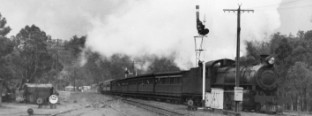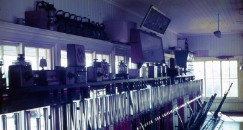Rivervale
WAGR - South Western Railway (S. W. R.) | |
1938 WAGR MAP Mileage = 3 | |
| Location Map | |
Next Down Station: | Next Up Station: |
Quick Facts |
|
Opened |
Closed |
1952 |
1967 |
Mechanical |
Electrical |
55 Levers |
- |
Fate: Demolished |
|
Rivervale signal cabin was located on the suburban section of the W. A. G. R.'s South Western Railway and for many years was the junction of the double line to Armadale (the line being single track between Rivervale and East Perth (later named Claisebrook)) and worked by the Electric Staff system.
Interlocking was first brought into use at this station on 20th April 1899 when the station was named Burswood. The change of name from Burswood to Rivervale was effected in 1923. The name Burswood is naturally associated with the locale - being situated on what was called "Burswood Island" - (now thanks to land-fill, merely a sweeping loop in the Swan River). The return to the station's original name in recent years does however seem a little 'convenient' in that a large gambling establishment and entertainment complex of the same name was built near by!
The 1952 era cabin featured here, was required to facilitate the extra train movements into and out of the then expanding sidings at this station. This expansion was required due to additional rail traffic servicing the Swan Portland Cement works and James Hardy & Co. sidings nearby. The photo at left taken by Graham Watson in 1968, about a year after closure, shows that vandals have been active - breaking the center window in the interlocking room.
Also, all point rodding and signal wires / pulleys have been removed (as shown in C. Martin's photo which appeared on the cover of the September 1953 edition of the Railway Institute Magazine).
In this latter photo, the orientation of the lever frame shows that the Signalman faced west (towards the "Up" Main Line) which gave him a clear view of the Great Eastern Highway level crossing at the Victoria Park end of the yard and all the sidings under his control.
Note the silhouette of the Staff Instrument to East Perth (later named Claisebrook) which can just be seen to the left of centre window frame upright of the operating floor. Below the interlocking room, one can make out signal wire pulleys which no doubt had signal wire adjusters below.
Even during the very early years of the station, Electric Staff was the means of control between the other stations to the south of Rivervale. Following the duplication of the line towards Armadale in 1904, Winters' Two-position Block working was introduced. This was in use until 31st of July 1966 when Automatic, Colour-light Signalling was introduced.
Rivervale, worked on the northwest side with Goodwood or Claisebrook (formerly named East Perth), and to the South with (depending on who was 'cut-in' at the time) Carlisle, Welshpool, Cannington, Maddington, Gosnells, Kelmscott or Armadale.
The 55 lever frame used at Rivervale is said to have once been used at the country station of Southern Cross on the Eastern Goldfields Railway. Reports have also been received that following the cabin's move from Southern Cross, the Rivervale signal cabin's lever frame was 're-locked' using Tappet Locking, a system quite different from the normal Cam and Soldier rotary locking normally used on these McKenzie & Holland lever frames. If proved correct, this was possibly the first major installation of such interlocking to a signal cabin frame here in Western Australia known to SignallingWA This may have been the origin of the drawing (on file) showing just such an adaption of the W. A. G. R.'s standard McKenzie & Holland No. 9 Pattern frame. The fact that the fibro-clad cabin had been fitted (unusually) with sash windows and no evidence of front removable 'hatches' normally provided in cabins to facilitate the extraction or replacement of T-irons in the lever frame may support the earlier Tappet-locking' claim.
STOP PRESS! With the discovery of Graham Watson's photo (above), comes evidence that there were indeed 'hatches' on the front of this building. These can be seen each side of the interlocking room windows. (Any further information on the Tappet-locking claim - either way - would be greatly appreciated - Ed.).
During the years of Electric Staff working between Claisebrook (formerly named East Perth), Goodwood and Rivervale these sections were subject to some interesting experiments. It is reported, though yet to be confirmed from official records by SignallingWA, that a system of Automatic Staff Exchanging was trialled at these stations. This required special trackside and locomotive-mounted equipment and it is believed to have been quickly discontinued. Former Rivervale Signalman Ron Coleman recalls: "The Staff Exchanger was to save the Block Boy from having to leave his duties in the cabin to give or receive the Staff, and was in use until C.T.C. was introduced between the cabins."
Staff working over these sections was replaced in March 1955 with an installation of Centralised Traffic Control (C. T. C.) worked from the small Goodwood control panel located in the Claisebrook (formerly named East Perth) signal cabin. The Signals and Telecommunications Engineer who directed the W.A.G.R.'s design and construction team for this installation was Donald Charles Curtis who came to W. A. from New Zealand. During the many changes brought about by the conversion to colour light signalling, for a short period of time No. 1 Signal (formerly No. 53 Down Starter at the south end of the platform) was worked via a small signal panel in the Station Master’s office.
The 1966 Diagram of Signalling for Rivervale - C. C. E. Plan 57092 one can note the various 'spares' throughout the frame and the 'spaces' where levers 14, 26 to 30 and 42 ought to have been - meaning that there were no levers provided in these places.
These days, nothing can be seen of either of the two Rivervale signal cabins. The old track formation has largely disappeared under recent buildings and the new track alignment now sports concrete overhead line gear masts for the electrified suburban system. In fact, the first overhead gear mast was placed in the ground at Rivervale! A bitumized footpath now runs along the sand bank that is all that remains of the original Rivervale (Burswood) platform. A slight depression in this is the only indicator of the original Burswood signal cabin's location. On the south side of the Great Eastern Highway rail overpass however, the sharp-eyed observer can still make out the tarmac of the original highway level crossing which has some rails still in place - these are on the Red Castle Hotel side of the line.
Information researched and interpreted by Chris. J. E. French of SignallingWA
Additional information supplied by Robert Pearce and Ronald Coleman and Arthur Makin
Any additional information on this signal cabin would be most welcome - please use the e-mail form provided on this page.
Photographs © by Graham Watson, C. Martin and Diagram of Signalling by W. A. G. R.
Buy this page or View your SignallingWA Shopping Cart
This page is copyright, and permission must be sought from SignallingWA before this page is used for any purpose other than personal education.
RIVERVALE Employees | ||
This list may not be complete and does not yet include employees who worked here without being appointed. Where an appointment date is unknown, the Weekly Notice (WN) date advising of the appointment or other official documentation, i.e. Certificate of Competency (CC) will be used. | ||
Name | Appointed | Position |
Milmoe, Eugene | 19/08/1959 | Signalman |
Street, Leonard Stanley | 17/06/1961 - W. N. 23 / 1961 | Signalman, Class 2 |
Street, Leonard Stanley | 17/10/1961 | Signalman, Class 2 |
Is a name missing? Please submit any corrections / additions with suitable evidence using the e-mail form above. | ||


